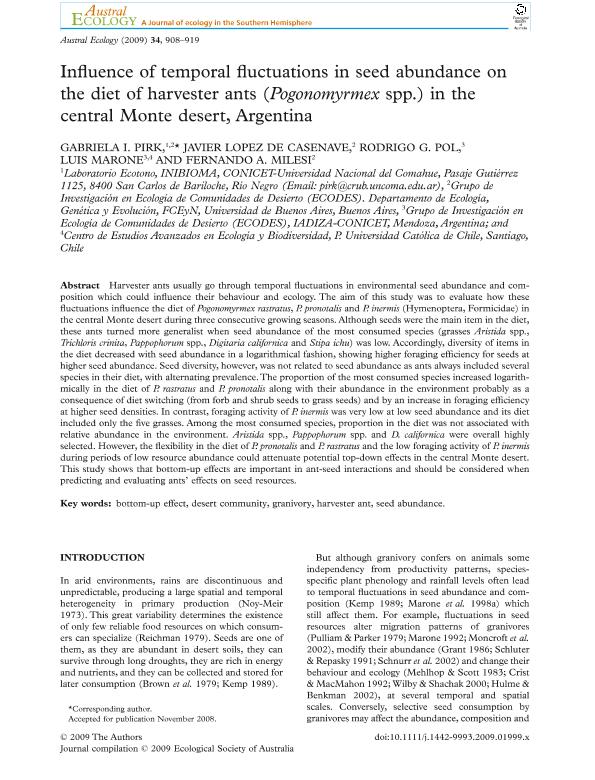Mostrar el registro sencillo del ítem
dc.contributor.author
Pirk, Gabriela Inés

dc.contributor.author
Lopez de Casenave, Javier Nestor

dc.contributor.author
Pol, Rodrigo Gabriel

dc.contributor.author
Marone, Luis

dc.contributor.author
Milesi, Fernando Adrian

dc.date.available
2019-05-27T22:09:46Z
dc.date.issued
2009-12-19
dc.identifier.citation
Pirk, Gabriela Inés; Lopez de Casenave, Javier Nestor; Pol, Rodrigo Gabriel; Marone, Luis; Milesi, Fernando Adrian; Influence of temporal fluctuations in seed abundance on the diet of harvester ants (Pogonomyrmex spp.) in the central Monte desert, Argentina; Wiley Blackwell Publishing, Inc; Austral Ecology; 34; 8; 19-12-2009; 908-919
dc.identifier.issn
1442-9985
dc.identifier.uri
http://hdl.handle.net/11336/77279
dc.description.abstract
Harvester ants usually go through temporal fluctuations in environmental seed abundance and composition which could influence their behaviour and ecology. The aim of this study was to evaluate how these fluctuations influence the diet of Pogonomyrmex rastratus, P. pronotalis and P. inermis (Hymenoptera, Formicidae) in the central Monte desert during three consecutive growing seasons. Although seeds were the main item in the diet, these ants turned more generalist when seed abundance of the most consumed species (grasses Aristida spp., Trichloris crinita, Pappophorum spp., Digitaria californica and Stipa ichu) was low. Accordingly, diversity of items in the diet decreased with seed abundance in a logarithmical fashion, showing higher foraging efficiency for seeds at higher seed abundance. Seed diversity, however, was not related to seed abundance as ants always included several species in their diet, with alternating prevalence. The proportion of the most consumed species increased logarithmically in the diet of P. rastratus and P. pronotalis along with their abundance in the environment probably as a consequence of diet switching (from forb and shrub seeds to grass seeds) and by an increase in foraging efficiency at higher seed densities. In contrast, foraging activity of P. inermis was very low at low seed abundance and its diet included only the five grasses. Among the most consumed species, proportion in the diet was not associated with relative abundance in the environment. Aristida spp., Pappophorum spp. and D. californica were overall highly selected. However, the flexibility in the diet of P. pronotalis and P. rastratus and the low foraging activity of P. inermis during periods of low resource abundance could attenuate potential top-down effects in the central Monte desert. This study shows that bottom-up effects are important in ant-seed interactions and should be considered when predicting and evaluating ants' effects on seed resources.
dc.format
application/pdf
dc.language.iso
eng
dc.publisher
Wiley Blackwell Publishing, Inc

dc.rights
info:eu-repo/semantics/openAccess
dc.rights.uri
https://creativecommons.org/licenses/by-nc-sa/2.5/ar/
dc.subject
Bottom-Up Effect
dc.subject
Desert Community
dc.subject
Granivory
dc.subject
Harvester Ant
dc.subject
Seed Abundance
dc.subject.classification
Otras Ciencias Biológicas

dc.subject.classification
Ciencias Biológicas

dc.subject.classification
CIENCIAS NATURALES Y EXACTAS

dc.title
Influence of temporal fluctuations in seed abundance on the diet of harvester ants (Pogonomyrmex spp.) in the central Monte desert, Argentina
dc.type
info:eu-repo/semantics/article
dc.type
info:ar-repo/semantics/artículo
dc.type
info:eu-repo/semantics/publishedVersion
dc.date.updated
2019-05-03T17:37:25Z
dc.journal.volume
34
dc.journal.number
8
dc.journal.pagination
908-919
dc.journal.pais
Reino Unido

dc.journal.ciudad
Londres
dc.description.fil
Fil: Pirk, Gabriela Inés. Consejo Nacional de Investigaciones Científicas y Técnicas. Centro Científico Tecnológico Conicet - Patagonia Norte. Instituto de Investigaciones en Biodiversidad y Medioambiente. Universidad Nacional del Comahue. Centro Regional Universidad Bariloche. Instituto de Investigaciones en Biodiversidad y Medioambiente; Argentina. Universidad Nacional del Comahue. Centro Regional Universitario Bariloche. Laboratorio de Ecotono; Argentina
dc.description.fil
Fil: Lopez de Casenave, Javier Nestor. Consejo Nacional de Investigaciones Científicas y Técnicas; Argentina. Universidad de Buenos Aires. Facultad de Ciencias Exactas y Naturales. Departamento de Ecología, Genética y Evolución. Grupo de Investigación en Ecología de Comunidades del Desierto; Argentina
dc.description.fil
Fil: Pol, Rodrigo Gabriel. Consejo Nacional de Investigaciones Científicas y Técnicas. Centro Científico Tecnológico Conicet - Mendoza. Instituto Argentino de Investigaciones de las Zonas Áridas. Provincia de Mendoza. Instituto Argentino de Investigaciones de las Zonas Áridas. Universidad Nacional de Cuyo. Instituto Argentino de Investigaciones de las Zonas Áridas; Argentina. Universidad de Buenos Aires. Facultad de Ciencias Exactas y Naturales. Departamento de Ecología, Genética y Evolución. Grupo de Investigación en Ecología de Comunidades del Desierto; Argentina
dc.description.fil
Fil: Marone, Luis. Consejo Nacional de Investigaciones Científicas y Técnicas. Centro Científico Tecnológico Conicet - Mendoza. Instituto Argentino de Investigaciones de las Zonas Áridas. Provincia de Mendoza. Instituto Argentino de Investigaciones de las Zonas Áridas. Universidad Nacional de Cuyo. Instituto Argentino de Investigaciones de las Zonas Áridas; Argentina. Universidad de Buenos Aires. Facultad de Ciencias Exactas y Naturales. Departamento de Ecología, Genética y Evolución. Grupo de Investigación en Ecología de Comunidades del Desierto; Argentina. Universidad Católica de Chile; Chile
dc.description.fil
Fil: Milesi, Fernando Adrian. Consejo Nacional de Investigaciones Científicas y Técnicas; Argentina. Universidad de Buenos Aires. Facultad de Ciencias Exactas y Naturales. Departamento de Ecología, Genética y Evolución. Grupo de Investigación en Ecología de Comunidades del Desierto; Argentina
dc.journal.title
Austral Ecology

dc.relation.alternativeid
info:eu-repo/semantics/altIdentifier/doi/http://dx.doi.org/10.1111/j.1442-9993.2009.01999.x
dc.relation.alternativeid
info:eu-repo/semantics/altIdentifier/url/https://onlinelibrary.wiley.com/doi/abs/10.1111/j.1442-9993.2009.01999.x
Archivos asociados
